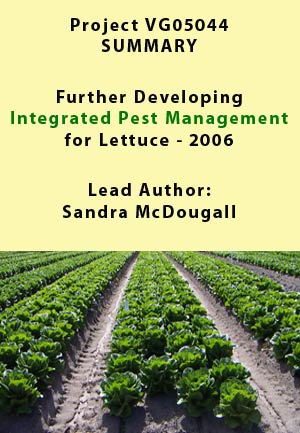|
Current Lettuce Aphid, Nasonovia ribis nigri (CLA) is currently throughout Tasmania, in the lettuce growing areas in and around Melbourne, Adelaide and Sydney basin. CLA is found in central western NSW and Tamworth.
Integrated Pest Management is considered by entomologists and some growers as being the best long term strategy for managing all pests, including lettuce aphid.
This project will build on the work being conducted in Tasmania and with key entomologists in each state, commercial IPM consultants working in the lettuce industry and lettuce growers to develop confidence that lettuce aphid can be managed under a biologically based IPM.
Authors
|
|
Sandra McDougall
|
Kathryn Bechaz
|
|
Greg Baker
|
Sonia Broughton
|
|
Virginia Brunton
|
John Duff
|
|
Lionel Hill
|
Paul Horne
|
|
Tony Napier
|
Len Tesoriero
|
|
Leigh James
|
|


The areas of study include :
- Demonstration-trials of biological IPM in 2 states each year..
- A series of field sessions for local growers, consultants and industry people will be held with IPM consultants at the sites to follow the strategies in action for the life of the crop.
- Lettuce Aphid population dynamics in each area and the important weed hosts.
- Trials of new chemical options for Lettuce Aphid and other lettuce pests
- Pesticide impacts on beneficials (both acute toxicity and on ability to reproduce) e.g imidacloprid effects on predatory mites, Case studies of IPM growers
- Lettuce Leaf bimonthly newsletter is sent to all lettuce growers and key industry people to publicise project results and case studies
- IPM tools such as identification materials for separating different aphids on lettuce, lettuce aphid weed host poster and training resources to support consultants.
- Web access for project results and trial reports.
- LA Advisory Group will be involved with annual report-backs and setting workplans for each region.
Summary :
- The project funded has demonstrated on commercial field head lettuce sites that a biologically based IPM strategy can successfully manage CLA and other lettuce pests in Victoria and Tasmania.
- On farm field days and demonstrations will be held at both Victorian and Tasmanian IPM trial sites.
Growers had the opportunity to see how IPM strategies can be implemented to effectively manage insect pests.
- A survey of arthropod populations in soils collected from lettuce fields identified two species of predatory mite as potential biological control agents of pests such as thrips, aphids, small grubs and pest mites.
- A survey of Lettuce growers from around the country identified attitudes towards the adoption of IPM practices.
- A survey of consultants serving the lettuce industry identified their attitudes and ability to deliver a biological IPM service. The study also identified the necessary training and support materials to improve their skills in IPM and extend their service to growers.
- Case Studies of IPM businesses and similar businesses that are non-IPM from lettuce growing areas. The studies addressed attitudes towards pest management, levels of crop damage and an economic comparison.
- All lettuce growers and allied industry people have been receiving bimonthly Lettuce Leaf newsletters, these are also available from the NSW DPI web site.
Acknowledgments :
This project was supported by the National Vegetable Levy, State Governments and AusVeg
The authors wish to thank members of the AUSVEG Leafy Veg committee including: Eddie Galea (NSW), Denise Harslett (QLD), Lorry De Ruvo (SA), Colin Houston (TAS), Tom Schreurs (VIC), Maureen Dobra (WA), Patrick Ulloa (IDO).
The authors also acknowledge the contribution of industry representatives: Michael Bergman (GSF), Arie Baelde (Rijk Zwaan), Peter Dal Santo (Ag Aware) and Brad Wells (HAL).
|

